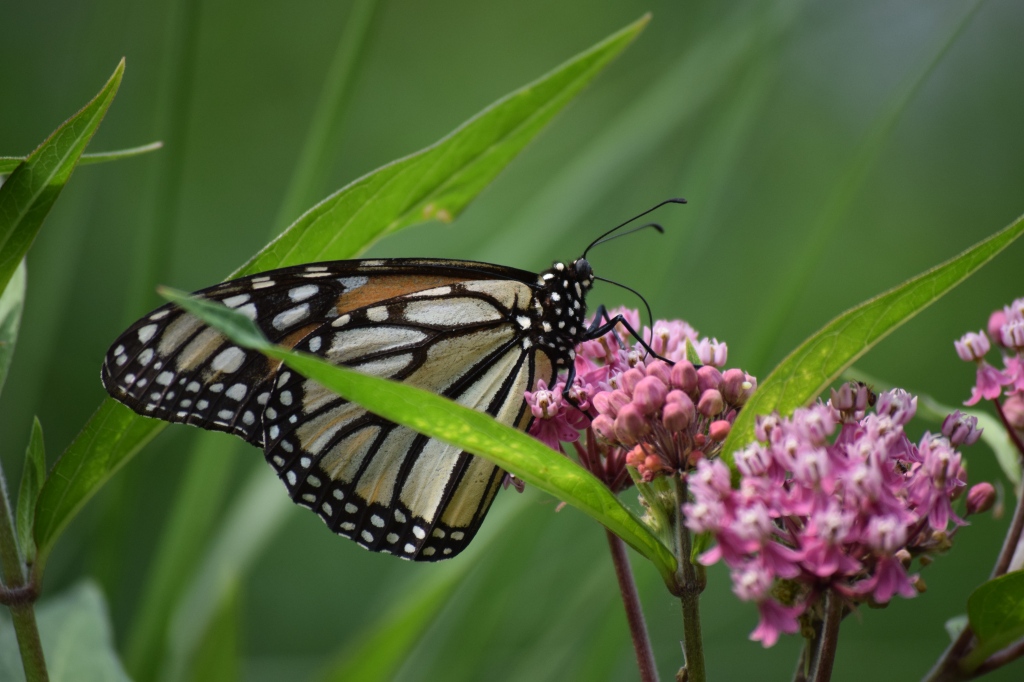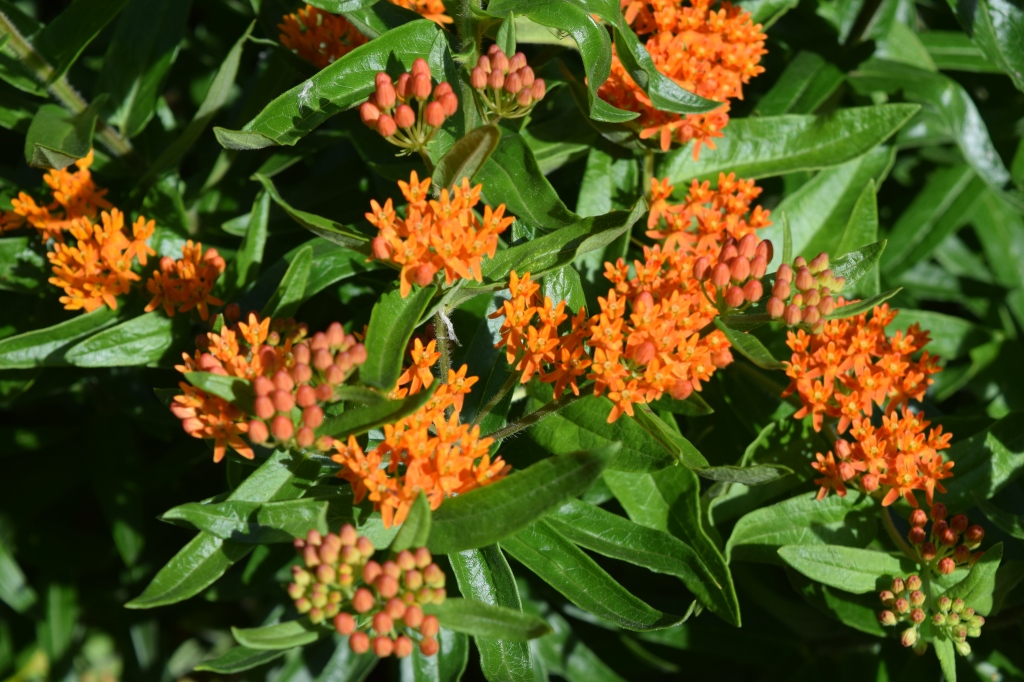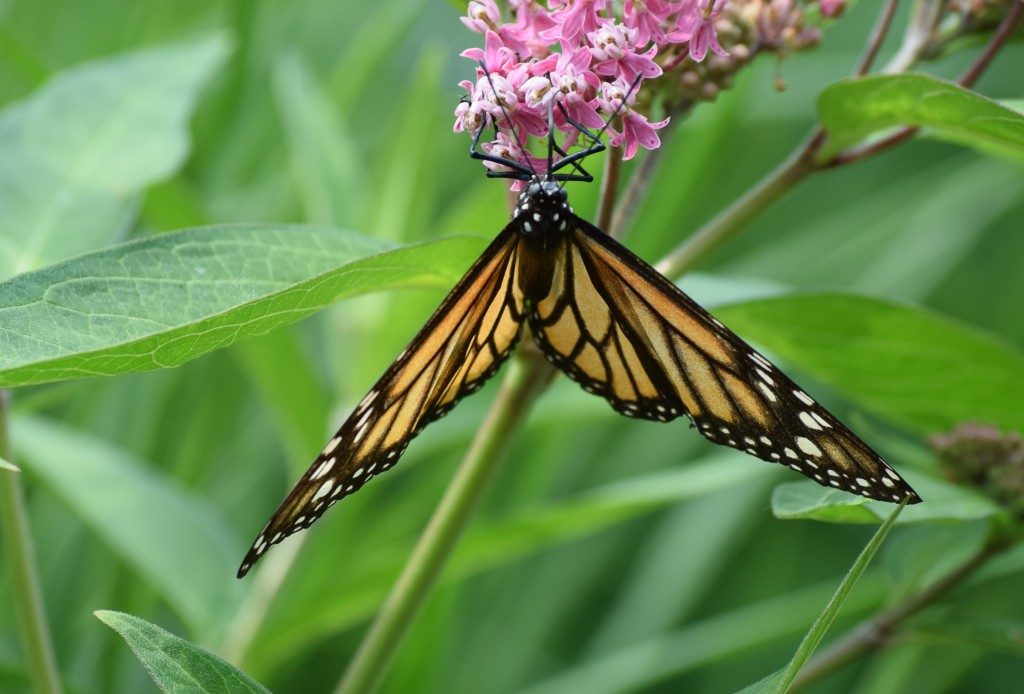Don’t Give Up On Monarch Butterflies
For about a week there’s been a single Monarch Butterfly flying around our garden, and paying particular attention to the Swamp Milkweed (Asclepias incarnata). After I got a fuzzy picture with my phone, Judy sat outside on the front steps waiting for the Monarch to appear so she could get these photos with her Nikon and telephoto lens.

I’d like to think that this Monarch was testing out the Milkweed for laying eggs. (Can anyone tell from these photos if this is a male or female?). The front garden has big patches of Swamp Milkweed and Butterflyweed (Asclepias tuberosa), but I have never seen a single Monarch caterpillar. As you probably already know, Monarch caterpillars eat only Milkweed plants.

It’s always exciting when the Monarchs make their appearance in the garden. Even so, it bothers me to see this single butterfly on its own. It reminds me how common they used to be as recently as the 1990s. Since then we have lost more than 90% of the Monarch population.

Conservationists have petitioned the U.S. Fish and Wildlife Service to add Monarchs to the Endangered Species List, but the lengthy review process means there will be no decision until 2016. In the meantime, individual gardeners, especially in the Midwest, can help by planting Milkweed in their gardens. There are several species that are extremely ornamental and much less aggressive than the Common Milkweed (Asclepias syriaca).
Since I already have lots of Milkweed, I’ve decided that this year I am going to badger at least five friends or neighbors into accepting young Milkweed plants for planting this fall. I’ll show up with a shovel and plant them myself. In secret, if I have to.
I’ll also continue to give away free Purple Milkweed (Asclepias purpurascens) seeds this autumn for the second year in a row.
It’s a very small thing on its own, but I want to feel like I did something extra so that we can all have a few Monarchs in our gardens in future years. I want that lone Monarch to be a beginning, and not an end.






Great photos! It looks to me like it’s a female, since I don’t see those black spots on the hindwings. I’m not seeing many Monarchs this year. I hope that changes before the summer is out. I do remember a time when they were extremely plentiful. I hope my grandchildren and great nieces and nephews will have a chance to see them. Great approach to share your Milkweed with friends and neighbors. 🙂
I hope you are right that it’s a female. I’ll keep hoping to find caterpillars!
That’s a wonderful thing to do, Jason. While I’ve seen several Red Admirals this summer, I’ve only seen 1 Monarch. I think, however, that the cool, rainy weather we’ve been having all summer is a factor. Other than the Red Admirals that i see every day (and, of course, Cabbage Whites) I haven;t seen hardly any butterflies and very few bees.
I think you are right about this year’s weather being a factor. Early on I saw commas and mourning cloaks and I think there are American snouts. I haven’t seen any swallowtails yet.
Pro-active, I like that. Shame you are so far away. I grew some last year, but they didn’t come back.
Do you have Monarch butterflies in the UK?
Love your thinking on the guerrilla planting of the milkweed.
I’m thinking of spreading seed in the weedy areas near train stations.
Brilliant!
Here’s to new beginnings because as I’ve lamented before, it has now been three years since I’ve seen a Monarch. They use to spend the summer with us, and we welcomed them every year. We are seeing a lot less native pollinators as well this year. I’m concerned for us.
It is very concerning. We just have to take what actions we can, hope for the best, and savor whatever time we get to observe these creatures.
Jason, Thank you for continuing to talk about the plight of the monarch and for the great photos. The community pollinator garden/monarch waystation we installed in our neighborhood park this spring has had one monarch sighting; that too on swamp milkweed.
The purple milkweed seed you sent me last fall did not germinate for me or for the friend with whom I shared them. I was able to get a couple of baby plants from Shooing Star Nursery in Georgetown, Kentucky at the end of June and have them fenced in. Keeping fingers crossed!
That’s too bad the seed did not germinate. Did you chill them before planting? Or did you plant them outside in the fall? Anyway, I hope the plants from Shooting Star thrive for you!
Sown by both of us in our gardens on receipt. It was such a strange winter that some plants that should have survived, didn’t and others, long forgotten, reappeared.
Ah, that’s too bad. Direct sow in the fall should work, but as you know there are so many unpredictable factors, weather especially. I just had a Dutchman’s Pipe Vine show itself after I thought it was dead for a couple of years. I had thought it never established.
You have a female! The male has a black dot on the lower wing (for releasing pheromones that attract mates) while the female has thicker wing veins like this one.
Hurrah! Thanks for the info. Maybe we’ll see some caterpillars after all.
Well done. Hopefully this monarch is just a scout for a nice nursery.
That’s exactly what I’m hoping.
Great pictures of the Monarch. I’ve only ever seen them here in NC in late summer/fall. The NC Botanical Garden (NCBG) is doing a 4-month long series on pollinators (well-attended I might add). This week’s talk mentioned the NCBG has a “Partners for Fish and Wildlife grant to grow 7,200 plugs of common milkweed (Asclepias syriaca) for future distribution and to create a local seed source for additional monarch habitat projects.”
I’ve heard there are grants like that being given out around the country. It’s a step in the right direction.
Judy’s photos are wonderful! Although my coneflowers are swarming with butterflies, I haven’t seen a single Monarch yet. Good for you for promoting milkweed for these iconic beauties. I’ve been encouraged to see so much milkweed growing along some of the roadsides this year. The word is getting out to more and more people–I hope this means a brighter future for the Monarchs.
I hope so, too. The guy who runs Monarch Watch wrote that he is optimistic there will be a modest recovery of the Monarch population at least for the short term. Longer term things are murkier.
Weirdly, I’ve seen a couple of Monarchs this summer–we shouldn’t have any right now, because they should all be up north in your garden. I had no Monarchs during the spring migration, but with our wet winter and spring, they didn’t have to visit urban gardens–there was plenty for them outside of cities. Your photos are lovely (I guess those are your wife’s?) I also have milkweed and it’ll be interesting to see if we have a good fall migration, Your lovely Monarch doesn’t have the black scent dots that the boys have–she’s a she!
Yes, they are Judy’s pictures (she takes almost all the pictures I post). Perhaps the cool weather up here has slowed the migration.
Seen quite a few Monarchs this year in our area. Got quite a few photos too of them on Milkweed, Common and Swamp. I know it is just hopeful, but it does seem like they are increasing in our area. We do have a Monarch breeder in the area that releases them and sells milkweed plants locally, so their mission seems to be working getting the word and milkweed out. A number of years in a row, I have been taking seed to the parks and watching “my” milkweed grow over time. It is good spreading the wealth…hope your neighbors allow you to plant your milkweed.
I’ve already gotten one volunteer.
Great, might get the ball rolling.
We would be happy to participate in the milkweed campaign. We have room in the former compost area. FYI, Greta L is an avid monarch fan. I witnessed her recently asking the Alderman if it would be alright if she took over a dormant street planter in her neighborhood for milkweed. You may want to recruit this young organizer for your campaign.
Thanks for volunteering! I’ll have to talk to Anders about Greta.
Good for you, I wish I could even talk to my neighbors about milkweed, since I am the outlier on the block if not the neighborhood. I have lots of milkweed this year that either planted itself or got transplanted early by birds and it’s just starting to bloom. But I haven’t seen many butterflies of any kind. Even yesterday at Lurie Garden…there were several Red Admirals and one non-stop “is it a Monarch or a Viceroy?” butterfly that I kept trying to see without binoculars and I think I finally decided it was a Viceroy (darn!). But I live in hope that the Monarchs, wherever they are, will have their milkweed sensors turned on and eventually find my yard. And yes, procreate.
I hope so, too! Keep me informed.
You go, Jason! I wish you lived nearby so I could take you up on your milkweed offer. But you’ve got me thinking that perhaps I could do so on my own, given that the milkweed would thrive in part sun/part shade at best. (I don’t call our home “the little house in the big woods” for nothing.” May that monarch in your garden lay many, may eggs.
Have you considered Purple Milkweed? It is more shade tolerant.
I love seeing monarchs! As a dad who has lost a baby at birth, the butterfly (usually the monarch) is used to represent the baby who has passed. Hospitals do this to alert staff when entering a hospital room, the butterfly picture would be put on the doorway. Since our daughters passing 5 years ago, we see the observation of a butterfly as a symbol of her showing up to say hello. Thanks for sharing!
So sorry to hear about your loss, and thank you for explaining the significance of the butterfly picture on the doorway.
hi, I’m new to your site, I don’t know where you live, but if you could get that plant to NJ, I would give it a try.
Hi, Gloria. Actually, I live in Chicago, but I could probably send you some small plants or divisions. What is your garden like – sunny, dry, moist, etc.
Let’s hope that this is the start of something big.
You never know.
Well that’s some good news. I have yet to see any here, but like others have said it’s been awfully rainy so I think that works against them. I’ve got a few milkweed around the yard but as of yet nothing on them. Lets hope you have some better luck!
Saw the same Monarch again today – I hope she is laying lots of eggs.
I haven’t seen a single monarch this season, just spangled fritillaries and swallowtails.
There is a small pond near here and I plan on scattering some swamp milkweed seeds along its banks when the ripen.
Sounds like a good idea.
Thank you thank you for your post about Monarchs. I have two patches of milkweed in my garden that I maintain for the monarchs. But I must admit that the scent of their flowers is maybe my very favorite of all. I have been growing the milkweed for four years. The first year, I did have monarchs and their caterpillars. Since then, not a one. I appreciate your quest to get friends and neighbors to join in the plantings. There’s a meadow near my home that is just screaming for milkweed. I think I’ll distribute a few pods there in the fall.
The Swamp Milkweed has a nice vanilla scent but I find it is the honey fragrance of common milkweed that is most delicious of all. I hope the Monarchs find you again soon.
Great idea on the guerrilla gardening. If you put them around the lampposts, people may just think the council did it and let them stay 🙂
Very good thought!
Hello Jason, those are some beautiful close-up pictures of Monarch butterflies. I can always tell when a particular picture is either taken by your or Judy, she is amazingly good with a camera!
Thanks, Sunil. I agree – Judy is amazingly good with a camera.
Nice that you have one in your garden and she is hanging around. I hope you find cats on your milkweed soon. I didn’t see any this spring but the past few years we’ve only seen them in our garden in the fall and no cats. We are a Monarch Waystation too. Your swamp milkweed is gorgeous. Mine hasn’t bloomed yet.
Most years I see a few Monarchs (never more than three at a time). They are usually around in July and August. I have some of their favorite fall nectar plantes (NE Aster, etc.), but I don’t see them in September.
Sadly, it has been a long time since I saw a monarch. I have tried to plant milkweed a couple of times, but the plants failed both times. I need to try again. I would gladly take a shovel-full of yours!
What kinds of Milkweed have you tried?
It’s great to see your monarch, Jason; I hope you get caterpillars. I have been letting Asclepias syriaca grow on my back slope, and it has been a host plant to hordes of milkweed tussock moth caterpillars; but I haven’t seen a monarch butterfly here in several years. Is there a way for me to get some of your A. purpurascens seeds? I just looked it up and it turns out to be native to Maine (although now rare in most of New England) and to like dry soil — perfect for my conditions!
I’d be happy to mail you some seeds after I harvest them in the fall. Just email me with your address. My email address is on the About/Contact page.
For the first time ever, I have self-sown swamp milkweed seedlings. I have loads of orange milkweed but am hoping the combination of the two will encourage the monarchs to visit my garden. I had a few last year but it could have been the same one visiting multiple times. I only had one caterpillar and I think birds ate it. 😦
I gave butterflyweed seedlings to a friend and she had caterpillars the next year. Go figure.
beautiful pics of a beautiful butterfly which we sadly don’t have around here. grew butterfly weed one year and loved it – hard to get though.
It’s funny that so many genera of American plants have become popular in European gardens before they did in America – Asclepias seems to be an exception.
What a wonderful post Jason, I’m cheering you on from here! Now if everyone had your attitude and was as pro-active the problem would soon be resolved! If you have to, go for it re planting in the middle of the night. It’s shocking to see how many species across the world are being depleted, a response like yours makes all the difference!xxx
Let’s hope so.
I had lots of monarchs last summer in my previous garden and will be curious to see how many might show up in this one. None of the buddleias have begun to flower yet. My last garden was close to the coast, whereas this one is about 15 miles inland — so I’m wondering if coastal areas might typically have more of them due to ‘flyways’ (similar to birds)?
That does make sense.
Hoping that female laid some eggs….I saw one flitting around but that has been it here and almost all the milkweed is sone blooming….plenty of favorite nectar plants though some I am still hopeful.
We have two Monarchs these days and they are hanging around the garden quite a lot.